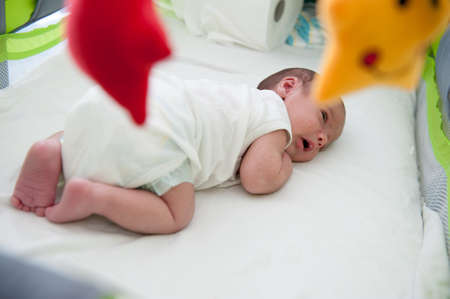1. Choose the Right Sleeping Space
Creating a safe and comfortable sleep environment for your newborn starts with selecting the right sleeping space. Your baby will spend many hours sleeping, so its important to choose a place that is both secure and soothing.
Safe Sleep Options
The American Academy of Pediatrics (AAP) recommends that newborns sleep in the same room as their parents for at least the first six months but on a separate sleep surface. Here are some common options:
| Sleeping Space | Description | Safety Considerations |
|---|---|---|
| Crib | A full-sized bed designed specifically for infants, typically used from birth through toddlerhood. | Ensure it meets current safety standards, with a firm mattress and fitted sheet. Avoid pillows, blankets, or stuffed animals. |
| Bassinet | A smaller, portable sleep space ideal for newborns up to around 4-6 months old. | Check weight limits and stability. The mattress should be firm and fit snugly. |
| Playard with a Bassinet Attachment | A multi-functional option that provides a safe sleep area and can be used beyond infancy. | The bassinet attachment should meet safety guidelines. Only use the mattress provided by the manufacturer. |
What to Avoid in Your Baby’s Sleep Area
- No loose bedding: Blankets, pillows, and stuffed toys increase the risk of suffocation.
- Avoid sleep positioners: Wedges or supports marketed for better sleep are not recommended by pediatricians.
- No crib bumpers: These pose a suffocation and entrapment hazard.
- No soft mattresses: A firm, flat mattress is best to reduce the risk of sudden infant death syndrome (SIDS).
The Importance of Room-Sharing Without Bed-Sharing
The safest place for your baby to sleep is in your room but in their own crib or bassinet. Sharing a room can help reduce the risk of SIDS while making nighttime feedings and comforting easier. However, bed-sharing increases the risk of accidental suffocation and is not recommended.
Your Baby’s Comfort Matters
Apart from safety, comfort plays an important role in creating a good sleep environment. Keep these tips in mind:
- Maintain a comfortable room temperature: The ideal range is between 68-72°F (20-22°C).
- Dress your baby appropriately: Use lightweight sleepwear or a wearable blanket instead of loose blankets.
- Create a calming atmosphere: Dim lighting and white noise machines can help soothe your baby to sleep.
Selecting the right sleeping space is one of the most important steps in setting up a perfect sleep environment for your newborn. By following these guidelines, you can ensure your little one sleeps safely and comfortably every night.
2. Maintain a Comfortable Room Temperature
Keeping your babys nursery at the right temperature is essential for creating a safe and cozy sleep environment. Babies are more sensitive to temperature changes than adults, so maintaining a consistent and comfortable room temperature can help them sleep better.
What Is the Ideal Nursery Temperature?
The recommended nursery temperature is between 68-72°F (20-22°C). This range helps prevent your baby from getting too hot or too cold, reducing the risk of overheating while ensuring they stay warm enough for restful sleep.
Tips for Maintaining a Comfortable Temperature
- Use a Room Thermometer: A digital thermometer can help you monitor the room temperature accurately.
- Avoid Overheating: Keep the crib away from direct sunlight, heaters, or air vents to prevent sudden temperature changes.
- Dress Your Baby Appropriately: Use lightweight, breathable sleepwear and follow the “one more layer” rule – dress your baby in one more layer than what you would wear comfortably.
- Use a Fan or Humidifier: A fan can improve air circulation, while a humidifier can help maintain comfortable humidity levels.
- Adjust Bedding and Swaddles: If your baby seems too warm, consider using a lighter swaddle or sleep sack instead of heavy blankets.
Signs Your Baby Might Be Too Hot or Cold
| If Too Hot | If Too Cold |
|---|---|
| Sweaty or damp skin | Cool hands and feet |
| Flushed cheeks | Pale skin or shivering |
| Irritability or restlessness | Lethargy or difficulty waking up |
Avoiding Sudden Temperature Changes
Babies are sensitive to sudden shifts in temperature. Try to keep the nursery door closed to maintain a steady environment, and use blackout curtains to help regulate room warmth during different seasons. In colder months, ensure there are no drafts near the crib, and in warmer months, use light clothing to prevent overheating.

3. Use Soft Lighting and White Noise
Dim lighting and soothing background noise can help create a calming atmosphere that encourages your baby to sleep more soundly. Newborns are highly sensitive to their surroundings, and the right combination of lighting and sound can make a significant difference in how well they rest.
Why Soft Lighting Matters
Bright lights can be overstimulating for babies, making it harder for them to wind down. Using soft, warm lighting in the nursery helps signal that its time to sleep. A dim environment mimics the natural transition from day to night, helping regulate your babys circadian rhythm.
Best Lighting Options for Your Babys Room
| Lighting Type | Benefits |
|---|---|
| Warm LED Nightlights | Provide gentle illumination without disrupting sleep cycles. |
| Dimmable Lamps | Allow you to adjust brightness according to your babys needs. |
| Blackout Curtains | Create a dark environment for daytime naps and early bedtimes. |
The Benefits of White Noise
A consistent background sound, like white noise, can mask household noises that might wake your baby. It also mimics the comforting sounds of the womb, helping newborns feel safe and secure.
Choosing the Right White Noise Source
- White Noise Machines: Designed specifically for babies, these devices offer a variety of soothing sounds.
- Fans or Humidifiers: Provide a subtle and continuous hum that can help drown out sudden noises.
- Soft Music or Lullabies: Gentle melodies can also have a calming effect on newborns.
Tips for Safe Use of White Noise
- Keep the volume low: The sound should be no louder than a soft shower (around 50 dB).
- Avoid placing it too close: Position the machine at least a few feet away from your babys crib.
- Use it consistently: Playing white noise during naps and nighttime sleep can create a familiar sleep cue.
A combination of soft lighting and soothing background noise can significantly improve your newborn’s sleep quality. By creating a peaceful sleep environment, you help set the foundation for healthy sleep habits as they grow.
4. Keep the Sleep Area Clutter-Free
Creating a safe sleep environment for your newborn means keeping their crib free from unnecessary items. While it may be tempting to decorate with cute pillows, blankets, or stuffed animals, these items can pose a serious risk.
Why a Clutter-Free Crib Matters
The American Academy of Pediatrics (AAP) recommends keeping the crib clear of soft objects to reduce the risk of sudden infant death syndrome (SIDS). Babies can accidentally roll into loose bedding or stuffed toys, which can obstruct their breathing.
Safe Sleep Essentials
To ensure a safe and comfortable sleep space, here’s what your baby’s crib should and shouldn’t have:
| Items to Include | Items to Avoid |
|---|---|
| A firm, flat mattress with a fitted sheet | Pillows, blankets, and quilts |
| A breathable mattress cover (if needed) | Bumper pads |
| Your baby in a well-fitted sleep sack or swaddle | Stuffed animals or plush toys |
Tips for Maintaining a Safe Crib Environment
- Avoid loose bedding: Use only a fitted sheet designed for your babys crib mattress.
- No extra accessories: Skip decorative pillows and plush toys inside the crib.
- Dress baby appropriately: Instead of blankets, use a sleep sack to keep your baby warm without added risk.
- Regularly check the crib: Ensure nothing extra has made its way inside during naps or bedtime.
A minimalist crib setup is not only safer but also helps your baby associate their crib with sleep rather than playtime. By keeping it free from clutter, you’re creating an environment that promotes safe and restful sleep.
5. Establish a Consistent Bedtime Routine
A predictable bedtime routine helps your newborn understand when its time to wind down for sleep. Babies thrive on consistency, and a regular nightly routine can make the transition to sleep much smoother.
Why a Bedtime Routine Matters
Newborns don’t yet understand day and night like adults do. A structured routine helps them associate certain activities with sleep, making it easier for them to settle down at night.
Simple Steps for a Calming Bedtime Routine
A good bedtime routine doesn’t have to be complicated. Here’s a simple structure you can follow:
| Step | Description |
|---|---|
| Warm Bath | A gentle bath can help relax your baby and signal that its almost bedtime. |
| Soft Pajamas | Dressing in comfortable sleepwear sets the stage for restful sleep. |
| Feeding Time | A full tummy can help your newborn sleep longer stretches. |
| Gentle Rocking or Cuddling | Swaying or holding your baby close provides comfort and security. |
| Lullaby or White Noise | A soft song or white noise can create a soothing sleep environment. |
| Dimming the Lights | A dark room signals that it’s time for rest. |
| Laying Baby Down Drowsy but Awake | This helps your newborn learn to self-soothe and fall asleep independently. |
Tips for Success
- Be Consistent: Try to do the same activities in the same order every night.
- Create a Calm Atmosphere: Keep lights dim and avoid loud noises before bedtime.
- Avoid Overstimulation: Limit playtime and excitement right before bed.
- Tweak as Needed: Every baby is different, so adjust the routine based on what works best for yours.
The Power of Routine
A consistent bedtime routine not only helps your newborn sleep better but also makes nighttime parenting easier. Over time, your baby will start associating these steps with sleep, leading to more restful nights for both of you.


